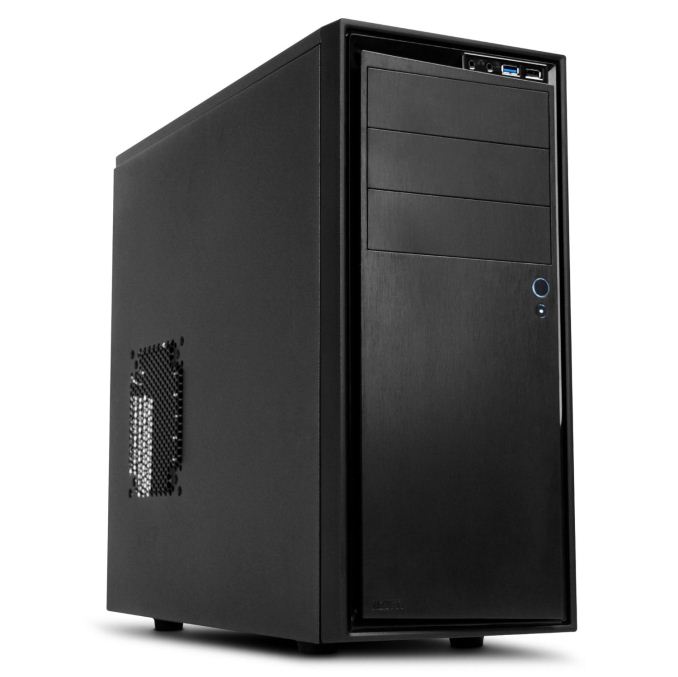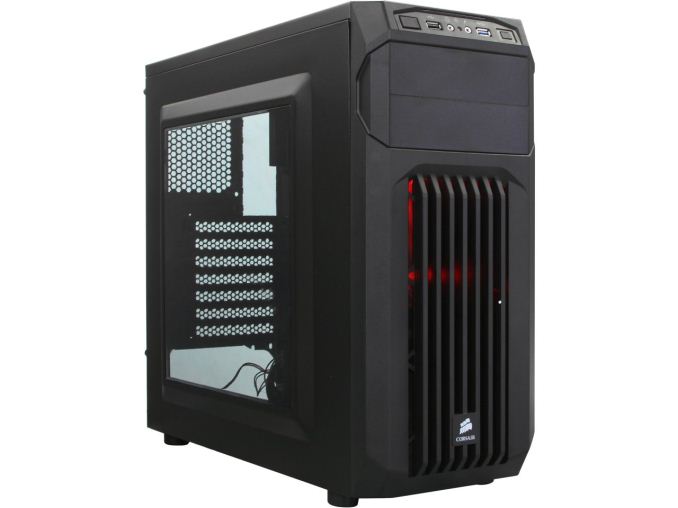Best PC You Can Build for Under $500
by Jarred Walton on August 1, 2014 11:11 AM EST
With yesterday's launch of AMD's 65W Kaveri APUs, it seemed a good time to give some recommendations for new system builds. We're starting out at the budget end of the spectrum, however, and pricing/availability on Kaveri generally rules it out. We'll keep things short and look at two builds, one AMD and one Intel. Outside of the CPU/APU and motherboard, parts are generally interchangeable.
| Budget AMD System | ||
| Component | Description | Price |
| CPU | AMD A6-6400K (2x3.9GHz, 1MB, 65W, 32nm) | $65 |
| Motherboard | MSI A88X-G41 | $73 |
| RAM | Team Vulcan 8GB (2x4GB) DDR3-2133 CL10 | $71 |
| Storage | Seagate Barracuda ST1000DM003 1TB | $55 |
| SSD | SanDisk Ultra Plus SDSSDHP-128G-G25 128GB | $60 |
| Case | NZXT Source 210 S210-001 | $40 |
| Power Supply | Seasonic SS-300ET 300W 80 Plus Bronze | $38 |
| Total (without OS) | $402 | |
The Kaveri APUs provide a decent blend of general and gaming performance, but finding one priced reasonably for a budget system is still a bit difficult (depending on your definition of budget, of course). While the idea of an inexpensive system capable of running games is fine, the cost to go from the A6-6400K we've selected to one of the Kaveri A10 models is more than the cost of a moderate dedicated graphics card like the R7 250, and the A6-7400K and A8-7600 are hard to find – and when you can find them, they're priced $15 higher than the MSRP. If you can wait a bit, the A6-7400K and A8-7600 should become more readily available. In the meantime, the A6-6400K will provide similar performance with a slightly slower graphics configuration.
 For the rest of the system, the MSI motherboard can support both existing Richland APUs like the A6-6400K we've selected as well as Kaveri APUs. Similarly, the DDR3-2133 RAM can provide better bandwidth than DDR3-1600 RAM that would only save you a buck. For storage, you've got three options: go pure SSD and have fast storage performance but without a lot of capacity, buy the 1TB HDD and sacrifice performance for capacity, or get both. Personally, I'd go with a pure SSD or the SSD+HDD configuration.
For the rest of the system, the MSI motherboard can support both existing Richland APUs like the A6-6400K we've selected as well as Kaveri APUs. Similarly, the DDR3-2133 RAM can provide better bandwidth than DDR3-1600 RAM that would only save you a buck. For storage, you've got three options: go pure SSD and have fast storage performance but without a lot of capacity, buy the 1TB HDD and sacrifice performance for capacity, or get both. Personally, I'd go with a pure SSD or the SSD+HDD configuration.
Wrapping things up, the case is a decent looking and not too expensive NZXT Source 210. Cases can be a very subjective topic, and there are plenty of reasonable options, but the NZXT is a good choice for a budget build. You could also drop down to a micro-ATX case and motherboard, and if that's what you're after the MSI A78M-E45 would be a good alternative. For the power supply, the small increase in efficiency offered by 80 Plus Gold isn't really worth the added cost at this price, and Seasonic makes a good 300W unit that will provide good efficiency for a low-power system like this while still allowing for the use of a moderate discrete GPU down the road should you choose to upgrade.
| Budget Intel System | ||
| Component | Description | Price |
| CPU | Celeron G1850 (2x2.9GHz, 2MB, 53W, 22nm) | $50 |
| Motherboard | Gigabyte GA-H97M-D3H | $80 |
| RAM | Team Vulcan 8GB (2x4GB) DDR3-1600 CL9 | $70 |
| Storage | Seagate Barracuda ST1000DM003 1TB | $55 |
| SSD | SanDisk Ultra Plus SDSSDHP-128G-G25 128GB | $60 |
| Case | Corsair Carbide Series SPEC-01 | $50 |
| Power Supply | Seasonic SS-300ET 300W 80 Plus Bronze | $38 |
| Total (without OS) | $403 | |
The Intel budget build is going to provide a pretty similar experience to the AMD build overall; single-threaded performance will be a bit higher, but graphics performance will be lower. The price for these two builds is equivalent at around $400 – which includes both a 128GB SSD and a 1TB HDD, so you can shave off $50 by dropping one or the other storage option. The Celeron G1850 is Intel's least expensive Haswell option right now, and while budget CPUs aren't going to win in any performance contests, for normal tasks they're still plenty fast. Paired with a 128GB SSD they can make for a decent home/office system and the price is certainly appealing. Overclocking isn't really a goal of either of these builds, and Gigabyte's GA-H97M-D3H should do fine for stock clocks.
 The one other noteworthy change is that we've included a slightly more expensive (and perhaps a bit too gaudy for some) Corsair Carbide SPEC-01 case. It has lots of angles and vents, and while Corsair has made some very good cases opinions on aesthetics are still up for debate. It ships with two 120mm fans for cooling, which is going to be overkill for a budget build like this but will give you room to grow. It also has a case window and red LED lighting for those that want to show off a bit.
The one other noteworthy change is that we've included a slightly more expensive (and perhaps a bit too gaudy for some) Corsair Carbide SPEC-01 case. It has lots of angles and vents, and while Corsair has made some very good cases opinions on aesthetics are still up for debate. It ships with two 120mm fans for cooling, which is going to be overkill for a budget build like this but will give you room to grow. It also has a case window and red LED lighting for those that want to show off a bit.
Of course we're still missing the OS, keyboard, mouse, and display; these are all commodity items and most people have existing accessories they can carry over from an old PC. Unless you're running a free OS like Ubuntu or some other flavor of Linux, the cost of Windows is going to represent a significant increase in price of nearly $100, putting us at the $500 mark referenced in the title. Adding a 20" to 22" LCD will tack on another $100-$140, and a keyboard and mouse will be $25 combined for a basic set. So all told if you want a complete new PC the price will be closer to $650, but $500 for the core system and software is a good starting point. You can also find some mail-in rebates on quite a few parts that might drop the price a bit, but as those change regularly I haven't included any in the above tables.










85 Comments
View All Comments
jaydee - Friday, August 1, 2014 - link
He was trying to point out nicely, that you cannot overclock at all without a Z-series mobo. H81 chipset won't overclock you at all.Dirk_Funk - Friday, August 1, 2014 - link
http://www.tomshardware.com/reviews/pentium-g3258-...Actually, with a BIOS update, you definitely can. And with a stock cooler, at that!
And just because I'm sure everyone who read this immedietely went and tried to beat this build like I did: http://pcpartpicker.com/p/NhDGbv DAT FPS/DOLLAR
DanNeely - Friday, August 1, 2014 - link
If that's typical of THG's current writing, they've really gone to hell since I last visited. Both in the garish buy links making the whole page look like an ad; and in not going into any detail about the H81 OCing. From reading the p1 text, I got the impression that MSI was selling boards that did something Intel's market segmenting said wasn't allowed out of the box. (At which point, my question was "how sure are they that Intel won't cut them off in punishment?"). Your comment here about needing a BIOS update puts a somewhat different spin on it: Is this an official bios update for the board? A bios hacked by a 3rd party? A bios for a similar z87 board that just happens to work? Something else entirely?hojnikb - Friday, August 1, 2014 - link
MSI never posted those bioses officially (i believe those bioses were"leaked"). And even then you're with an unofficial bios, that those extra features can be axed at any time with a future update, not to mention very poor power delivery (2+1 phase is really just good enough for stock and not for a overclocked cpu). It may work, but without heasinks, stability is questionable.mapesdhs - Friday, August 1, 2014 - link
Not necessarily, one doesn't need a top-end board to run the G3258 at a decent speed
even with the stock cooler. Indeed, toms used that very combination (G3258, H81M-P33,
stock cooler) to reach 4.4GHz @ 1.275V, at which it consistently beats an oc'd 750K.
Ian.
hojnikb - Friday, August 1, 2014 - link
In heavily threaded games, you're gonna have a much nicer experience with an overclocked 750K vs pentiumK overclocked.iLovefloss - Friday, August 1, 2014 - link
Really depends on your build. If you get a graphics card, then the Pentium-K will outperform any Kavari APU 10 times out of 10. If you're limiting yourself to iGPU, the opposite is true.hojnikb - Saturday, August 2, 2014 - link
750K will outperform pentiumK when thing get CPU limited. I wans't talking about apu, since athlon is gpulessiLovefloss - Saturday, August 2, 2014 - link
A Celeron is plenty powerful for a low-end budget build. Bottlenecked my ass. A Haswell Celeron should be at least as powerful as a Richland A8 APU, and even a Trinity A6 is perfectly fine for desktop usage. Even in gaming, you'll need a midrange card to bottleneck a Ivy-Bridge or Haswell desktop Celeron.I feel you're seriously overestimating you'd be doing with this type of build or underestimating what you can do with a Celeron. The only thing wrong with a Celeron is that it comes with a Pentium-grade iGPU, so it'll be worse than a similarly priced APU at gaming.
I, of course, agree with you that the motherboard selections (for both builds) are a bit extravagant for the purposes of these builds. B85 and H81 motherboards would be better for the Intel build, and AMD could go with something cheaper, too. I guess they wanted decent overall motherboards for upgrade purposes? I do want to point out that the H81M-P33 is closer to $50 and is a mATX board instead of microITX.
I guess you could give up the 8GB of RAM for 4GB (though 8GB would still be useful for a Celeron) since you have a SSD. However, I can see the logic behind that extra 4GB: iGPUs benefit from dual channel, and 8GB of RAM will deal nicely with memory hungry programs.
gicetifaf - Monday, August 4, 2014 - link
We're obviously not talking about doing just Facebook and Office here. Otherwise we would not have seen SSDs an H97 in the original article. They were probably thinking of a super-cheap mid-range PC on which you can do some gaming too.